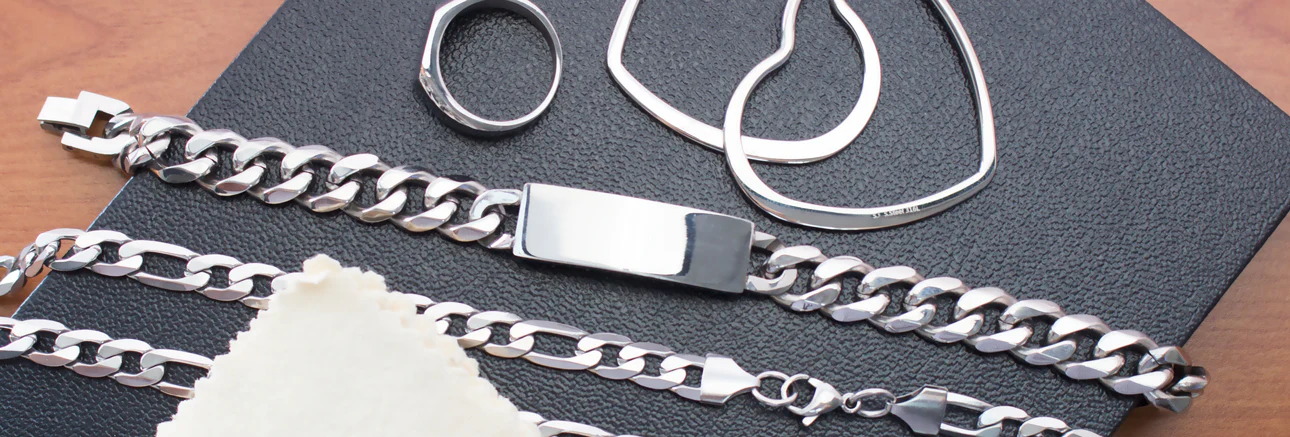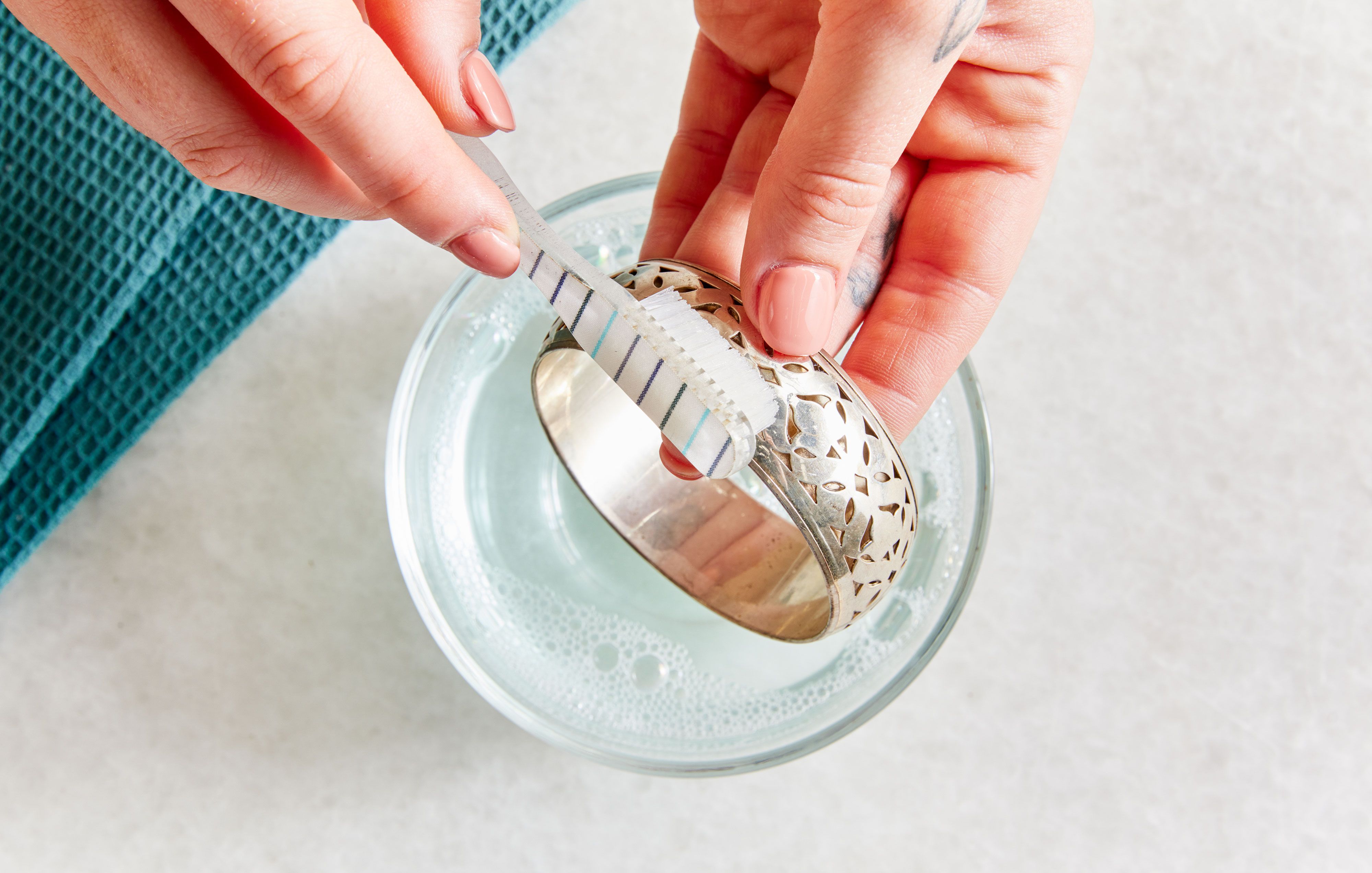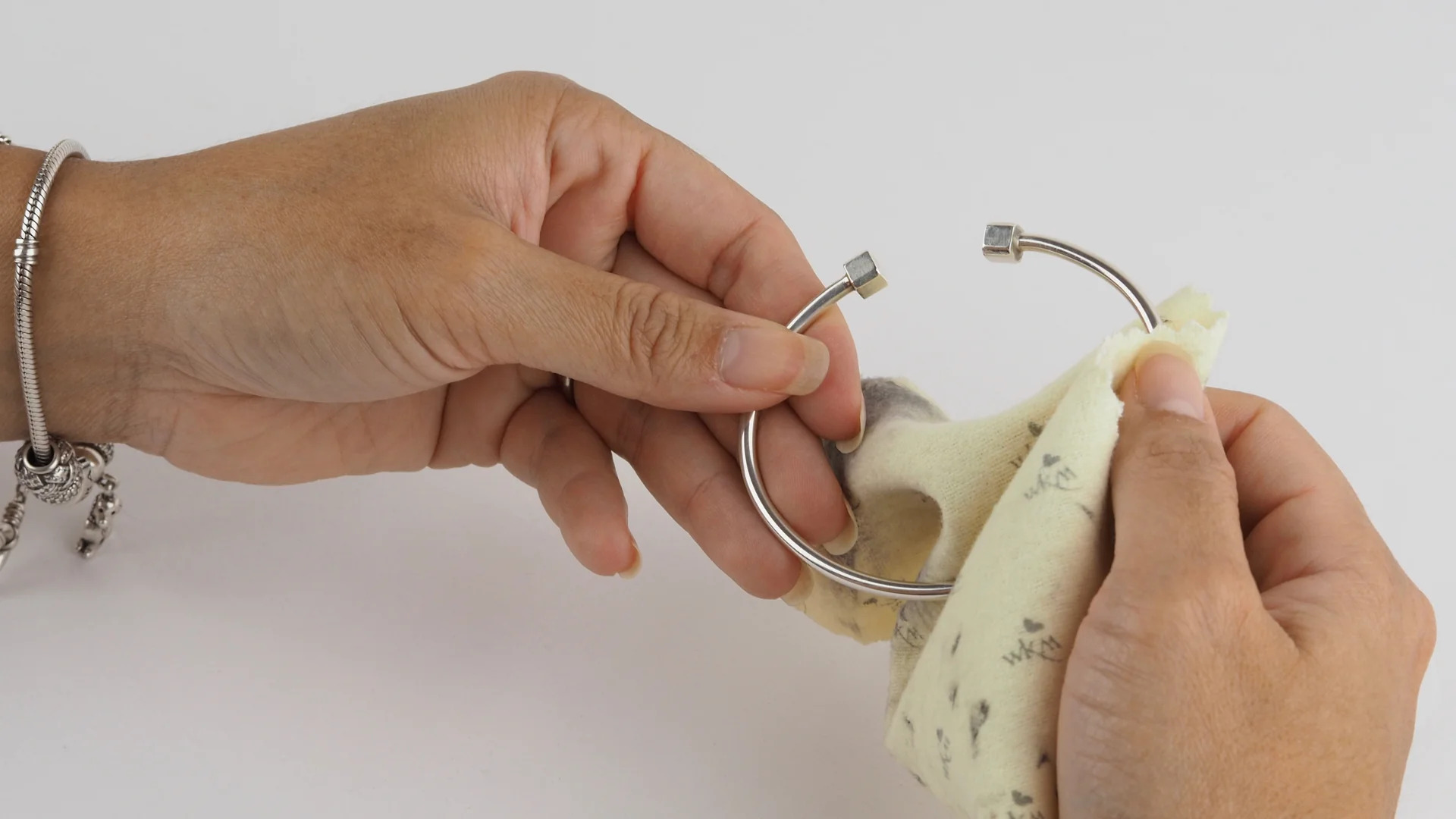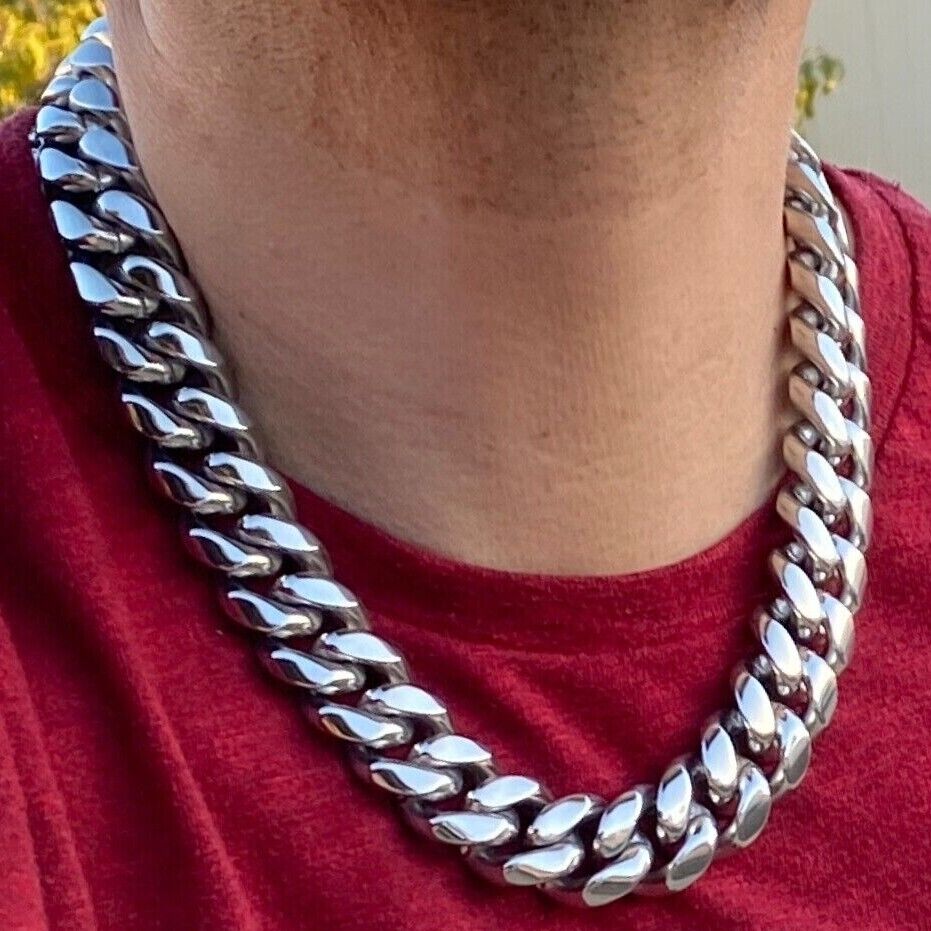
Stainless steel jewelryhas gained immense popularity for its durability, sleek appearance, and resistance to tarnishing. However, just like any precious metal, stainless steel jewelry requires proper care to maintain its lustrous finish.
Over time, exposure to oils, dirt, and environmental factors can lead to tarnishing or dullness. In this guide, we'll walk you through the best methods for cleaning your stainless-steel jewelry, ensuring it stays as stunning as the day you bought it.
1. Soap And Water - The Basic Cleaning Solution
The simplest way to clean your stainless-steel jewelryis by using warm water and mild soap. This method is perfect for routine cleaning and maintaining its luster.
Steps:
- Mix a small amount of mild dish soap with warm water in a bowl.
- Soak your stainless-steel jewelry in the soapy water for a few minutes.
- Use a soft cloth or a non-abrasive sponge to gently scrub away any grime or oils.
- Rinse the jewelry thoroughly under warm water.
- Dry it immediately with a soft microfiber cloth to prevent water spots.
This method works well for removing daily dirt, oils, and light tarnish, leaving your stainless-steel jewelry gleaming.
2. Baking Soda And Water - For Tough Tarnish
If your stainless-steel jewelry has accumulated stubborn tarnish or grime, baking soda can help restore its shine. Baking soda's mild abrasiveness helps scrub away more persistent buildup without scratching the surface.
Steps:
- Mix a tablespoon of baking soda with a few drops of water to create a paste.
- Apply the paste to your jewelry using a soft cloth or toothbrush.
- Gently scrub the tarnished areas in circular motions.
- Rinse thoroughly with warm water.
- Dry with a clean, soft cloth.
This method works great for removing oxidation or grease buildup, ensuring that your jewelry regains its luster.
3. Vinegar And Salt - For Stubborn Grime
For tougher tarnish or a more intense cleaning, a solution of vinegar and salt can be highly effective. This mixture will break down dirt and tarnish without causing damage to your stainless-steel jewelry.
Steps:
- Mix 1/4 cup of white vinegar with a teaspoon of salt in a bowl.
- Place your jewelry in the solution and let it soak for 5–10 minutes.
- Use a soft cloth or toothbrush to gently scrub away any tarnish.
- Rinse thoroughly with water and dry with a microfiber cloth.
While this method is powerful, avoid using it too frequently, as it may wear down the jewelry over time if used in excess.
4. Jewelry Cleaner - For Professional-Grade Results
For those who prefer a more convenient and professional approach, you can use a store-bought stainless steel jewelry cleaner. These cleaners are formulated to remove dirt and tarnish safely, providing a high-quality finish that restores the jewelry's original shine.
Steps:
- Apply a small amount of the jewelry cleaner to a soft cloth.
- Gently rub the surface of the jewelry, focusing on areas with visible tarnish.
- Rinse with warm water and dry with a clean microfiber cloth.
Jewelry cleaners can be a great option for those who have invested in high-end stainless-steel jewelry and want to maintain it with the best possible care.
5. Using A Polishing Cloth - For Extra Shine
After cleaning your stainless-steel jewelry, a polishing cloth can help to add an extra layer of shine and remove any residual streaks or fingerprints. Make sure to choose a polishing cloth that is safe for stainless steel to avoid any unwanted scratching.
Steps:
- Use the cloth to gently rub the surface of your jewelry in circular motions.
- Focus on the areas that need extra attention, such as dull spots or fingerprint marks.
Polishing cloths are an excellent final step in restoring your jewelry's shine, making it appear as good as new.
Why Stainless-Steel Jewelry Needs Cleaning
Stainless steel is known for its resistance to rust, corrosion, and tarnishing, which makes it a go-to metal for jewelry. However, while it's far more durable than other metals, stainless steel is not entirely impervious to damage. It can accumulate dirt, oils, and other residues from regular wear, leading to a dull or even discolored appearance. Additionally, chemicals in lotions, perfumes, or hair products can contribute to the tarnishing process.
Despite its resistance to corrosion, stainless steel can lose its shine over time if not properly cleaned and maintained. Unlike goldor silver, which can tarnish more noticeably, stainless steel jewelry typically shows signs of dullness before any major oxidation occurs.
How To Prevent Stainless Steel Jewelry From Tarnishing
While cleaning is important, prevention is just as crucial when it comes to maintaining the beauty of your stainless-steel jewelry. Here are some key tips to keep your jewelry looking great for longer:
- Store properly:When you're not wearing your jewelry, keep it in a clean, dry place. Consider using a jewelry boxwith individual compartments to avoid scratches. A sealed pouch or anti-tarnish bag is an excellent choice for extra protection.
- Avoid chemicals:Try to keep your jewelry away from harsh chemicals like bleach, chlorine, or cleaning products. These can damage the surface of the stainless steel over time.
- Take off when necessary:Remove your jewelry when swimming, showering, or engaging in strenuous activities. This will reduce exposure to moisture and chemicals, which can tarnish or dull the metal.
- Clean regularly:Regular cleaning (at least once a month) helps to keep your jewelry free from oils and grime that may cause buildup or tarnishing.
Types Of Stainless-Steel Jewelry
1. Rings
Stainless steel ringsare a favorite for their durability and stylish designs. They come in a variety of styles, including options from well-known jewelry brandsthat specialize in crafting elegant and affordable pieces.
- Wedding Bands:A budget-friendly yet elegant alternative to gold or platinum.
- Statement Rings:Featuring bold designs with engravings, textures, or set with gemstones.
- Minimalist Bands:Sleek, polished rings for everyday wear.
Stainless steel rings are scratch-resistant, hypoallergenic, and perfect for individuals looking for modern and affordable jewelry options.
2. Necklaces
Stainless steel necklacesare both stylish and practical, offering a polished appearance without the worry of tarnishing. Common designs include:
- Chains:From simple box chains to intricate rope designs, stainless steel chains are great for layering or wearing solo.
- Pendants:Stainless steel is often paired with pendantsfeaturing symbols, initials, or gemstonesfor a personalized touch.
- Statement Necklaces:Bold, chunky designs for those looking to make a statement with their jewelry.
Necklaces made from stainless steel are lightweight and easy to maintain, making them a popular everyday accessory.
3. Bracelets
Stainless steel braceletscome in a wide variety of styles, catering to different preferences:
- Cuff Bracelets:Sleek, modern cuffs that add sophistication to any outfit.
- Chain Bracelets:Delicate or bold chaindesigns, often worn as standalone pieces or stacked with other bracelets.
- Charm Bracelets:Durable chains featuring attachable charms for personalization.
These bracelets are highly resistant to scratches and tarnish, making them ideal for daily wear.
4. Earrings
Stainless steel earringsare known for being lightweight, hypoallergenic, and versatile. Popular styles include:
- Stud Earrings:Timeless and minimalist, often adorned with cubic zirconia or other stones.
- Hoop Earrings:Durable hoops available in various sizes and designs.
- Drop Earrings:Elegant styles that dangle below the earlobe, often paired with intricate designs or gemstones.
These earrings are especially suitable for individuals with sensitive skin, as stainless steel is less likely to cause irritation.
5. Watches
Stainless steel is widely used in watchmaking, offering a blend of durability and style. Types include:
- Classic Watches:Polished stainless steel cases with leather or stainless steel straps.
- Sport Watches:Durable designs made for active lifestyles, often featuring water resistance.
- Luxury Watches:High-end pieces with gold or rose gold plating and intricate detailing.
Stainless steel watches are valued for their long-lasting shine and resistance to wear and tear.
6. Chains And Anklets
Stainless steel chains are a versatile addition to any jewelry collection, and they come in a range of styles:
- Anklets:Thin, elegant chains designed to adorn the ankle, often with charms or beads.
- Chains for Pendants:Durable and stylish chains that pair well with pendants of various materials.
Both chains and anklets made from stainless steel are strong enough to endure regular wear while maintaining their polished appearance.
7. Body Jewelry
Stainless steel is a preferred material for body jewelry due to its hypoallergenic properties. It is one of the most popular body-safe materials, making it ideal for sensitive skin and preventing irritation. Common types include:
- Piercings:Stainless steel is often used for nose rings, belly button rings, and eyebrow piercings.
- Plugs and Gauges:Used in stretched ear piercings for their durability and ease of cleaning.
Body jewelry made from stainless steel is a safe and stylish choice, especially for those with sensitive skin.
8. Stainless Steel Jewelry With Inlays Or Accents
Many stainless steel pieces incorporate additional materials for added style and uniqueness:
- Wood or Resin Inlays:Often seen in rings or bracelets, adding texture and color.
- Gemstone Accents:Stainless steel jewelry with embedded gemstones or cubic zirconia for added elegance.
- Two-Tone Designs:Combining stainless steel with gold or rose gold plating for a sophisticated look.
These designs offer a contemporary take on traditional jewelry styles, making them ideal for modern fashion enthusiasts.
9. Personalized Stainless Steel Jewelry
Stainless steel is often used to create personalized jewelry, such as:
- Engraved Bracelets and Rings:Featuring names, initials, or meaningful dates.
- CustomPendants:Unique shapes or symbols tailored to individual preferences.
- ID Jewelry:Popular for medical ID bracelets or dog tag necklaces.
Personalized stainless steel jewelry is durable, affordable, and makes for meaningful gifts.
Do's Of Cleaning Stainless Steel Jewelry
1. Use A Soft Cloth Or Microfiber Towel
When cleaning your stainless-steel jewelry, always use a soft cloth or microfiber towel. These materials are gentle on the metal and help avoid scratching or dulling the surface. Microfiber towels, in particular, are excellent at picking up oils, dust, and fingerprints, leaving your jewelry looking polished without causing any damage. Avoid rough fabrics or abrasive cleaning materials, as they can cause fine scratches that are difficult to remove.
2. Clean Regularly To Remove Oils, Dirt, And Grime.
To keep your stainless-steel jewelry looking its best, it’s important to clean it regularly. Oils from your skin, dirt, and grime from daily wear can accumulate on the jewelry’s surface, causing it to lose its shine. By cleaning your jewelry at least once a month, you prevent this buildup, preserving the jewelry’s aesthetic and longevity.
3. Store Jewelry Properly
Proper storage is key to maintaining your stainless-steel jewelry’s condition. Always store it in a dry, cool place, away from direct sunlight and humidity. A jewelry box with individual compartments is a great option to keep each piece protected from scratches or tangles. If possible, store your stainless-steel jewelry in an anti-tarnish pouch or bag, which helps protect it from moisture and environmental pollutants that can cause discoloration over time.
4. Test Cleaners On A Small Area Before Applying Them To The Entire Piece.
Before using any cleaning solution, whether homemade or store-bought, it’s a good idea to test it on a small, inconspicuous area of your jewelry. This ensures that the cleaner doesn’t cause discoloration or damage to the finish. A simple spot test will help you avoid any unexpected reactions, especially if you are using a new or unknown cleaner. This extra precaution ensures that the cleaning method you choose is safe for your jewelry.
Don'ts Of Cleaning Stainless Steel Jewelry
1. Avoid Abrasive Materials
Never use abrasive materials like steel wool, rough sponges, or harsh scrubbers when cleaning your stainless-steel jewelry. These materials can easily scratch the surface, leaving permanent damage that detracts from the jewelry’s appearance. Instead, opt for a soft microfiber cloth or a non-abrasive sponge to maintain the jewelry’s smooth and shiny finish.
2. Don’t Use Harsh Chemicals
Harsh chemicals, such as bleach, ammonia, or other industrial-strength cleaners, can be extremely damaging to stainless steel jewelry. These chemicals can cause the metal to corrode or lose its shine. Bleach, in particular, can discolor stainless steel, leading to irreversible damage. Always avoid using such cleaners on your jewelry, as they can compromise the integrity of the metal. Stick to gentle, jewelry-safe cleaning solutions for optimal results.
3. Avoid Wearing Jewelry During Activities Like Swimming Or Exercise
Stainless steel jewelry is generally resistant to tarnishing, but prolonged exposure to water, chlorine, saltwater, or sweat can lead to discoloration and gradual wear. Avoid wearing your jewelry while swimming, showering, or engaging in strenuous physical activities like exercise. These activities can cause your jewelry to come into contact with substances that may weaken its finish over time.
4. Don’t Leave Jewelry Exposed
Stainless steel is durable but exposing it to extreme heat or humidity for extended periods can affect its appearance and durability. High temperatures, such as those found in saunas or when jewelry is left in direct sunlight for too long, can cause discoloration or changes in the surface texture.
FAQs
How Often Should You Clean Stainless Steel Jewelry?
It’s recommended to clean your stainless-steel jewelry at least once a month, but more frequent cleaning may be necessary if you wear it daily or expose it to harsh elements.
Can You Use A Toothbrush To Clean Stainless Steel Jewelry?
Yes, a soft-bristled toothbrush is perfect for gently scrubbing off tarnish or grime from hard-to-reach areas without scratching the metal.
Does Stainless Steel Jewelry Tarnish Over Time?
While stainless steel is resistant to tarnishing, it can still accumulate dirt, oils, and grime, which can cause it to appear dull. Regular cleaning helps maintain its shine.
How Can I Remove Scratches From Stainless Steel Jewelry?
Minor scratches can sometimes be buffed out using a stainless-steel polishing cloth or a non-abrasive metal cleaner. For deeper scratches, professional repair may be required.
Conclusion
Stainless steel jewelry offers a durable and stylish option for everyday wear, but like any precious accessory, it requires proper care and cleaning to maintain its beauty. By following the simple cleaning methods outlined in this guide, you can easily restore your jewelry’s shine and prevent tarnishing.


